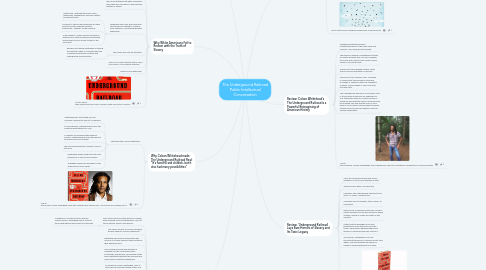
1. 'Underground Railroad' Traces the Terrible Wounds of Slavery
1.1. A novel of forgetting, yet arrives at a time when the United States collective memory regarding slavery and race hatred seems to be fading.
1.2. Whitehead's work is a portrayal of pre-Civil War America that honestly displays the inhumanity of slavery and the wounds, which still haven't healed, that slavery created.
1.3. Whitehead is one of America's greatest authors with both talent and range.
1.4. Link to article:'Underground Railroad' Traces The Terrible Wounds Of Slavery
2. Why White Americans Fail to Reckon with the Truth of Slavery
2.1. Colson Whitehead believes that if you want to understand both Black history and American history, that the understanding is in slavery.
2.2. We cannot pretend that white Americans have been well educated on the historical realities of slavery.
2.3. Whitehead plays fast and loose with chronology and setting to create a more cohesive, overarching thematic exploration.
2.3.1. Additionally, although the novel is well researched, Whitehead is less than faithful to historical facts.
2.3.2. Allusions to the forced sterilization of Black women and the Tuskegee Syphilis Experiment--chapter "South Carolina".
2.3.3. In the chapter "North Carolina" the state is depicted as a white supremacist state with enforcement tactics similar to that of the Holocaust.
2.4. The novels dips into the fantastic.
2.4.1. Readers first realize Whitehead is utilizing the fantastic when it is revealed that the Underground Railroad is literally and underground railway system.
2.5. This is not a neat narrative with a clean conclusion--it also resists optimism.
2.6. There is not a white hero.
2.7. Link to article: Why White Americans Fail To Reckon With The Truth Of Slavery
3. Why Colson Whitehead made The Underground Railroad Real: "It's fanciful and childish, but it also had many possibilities"
3.1. Interview with Colson Whitehead
3.1.1. Whitehead says the writing process included a significant amount of research.
3.1.2. In this interview, Whitehead discusses the character development of Cora.
3.1.3. In addition to discussing the research process, Whitehead discusses the general writing process of the novel.
3.1.4. The article discusses the concept of evil in the novel.
3.1.5. Whitehead shares insight into the vast differences in the novels he writes.
3.1.6. Whitehead shares his thoughts on the endorsement from Oprah.
3.2. Link to article:Why Colson Whitehead made the Underground Railroad real: “It’s fanciful and childish, but it...
4. Colson Whitehead on Bringing the Underground Railroad to Life
4.1. Plays with America's brutal history of slavery, while allowing Colson Whitehead to come to terms with his family's own history.
4.1.1. In addition to coming to terms with his family's history, Whitehead had to come to terms with what he would put Cora through.
4.2. Top Seller and was on former President Barack Obama's summer reading list.
4.3. Whitehead had a trying time writing this novel as it is vastly different than his typical light-hearted novels.
4.4. The Underground Railroad has been a metaphor for the complicated ways knowledge, safe houses, and escape routes were negotiated between the enslaved and free blacks and white sympathizers.
4.5. According to Colson Whitehead, over 16 years ago he took the childish notion of a literal railroad, of course underground, and toyed with the idea of a protagonist using an underground railway system that takes her multiple stops in which each stop is a new American possibility or an alternative America with its own rules.
4.6. There is a Gulliver's Travel type of system were the narrative reboots every 60 pages or so.
4.7. Whitehead plays with history, but by jumping between times and places and by playing with literal details, the fiction can enhance the truth of the experience.
4.8. Link to article: Colson Whitehead on bringing the Underground Railroad to life
5. The Perilous Lure of the Underground Railroad
5.1. Geography is a key plot componet.
5.1.1. South = iniquity and bondage
5.1.2. North = enlightenment and freedom
5.2. The Underground Railroad did not typically run below the Mason-Dixon Line--the railroad was a Northern institution. In Whithead's The Underground Railroad, his railroad runs into the deep south thus disrupting the reality of the Underground Railroad.
5.2.1. Although slavery was against the law in North, as a country the United States regarded slavery as a legitimate practice and respected the right of Southerners to own human beings.
5.2.1.1. Created a moral disaster for the United States and terror for fugitive slaves.
5.3. Slavery = institutional
5.3.1. Underground Railroad = Personal
